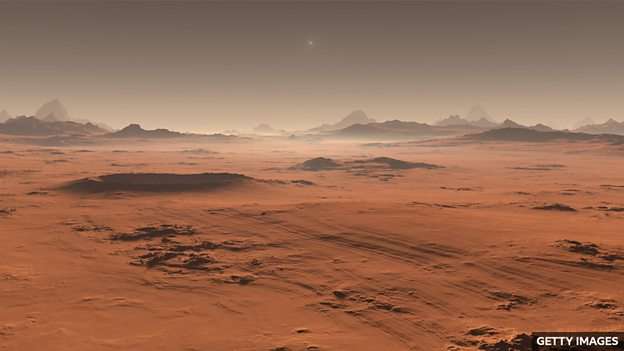媒体英语
Reservoir of liquid water found deep in Martian rocks 科学家发现火星地表下深藏液态水库

科学家们在火星岩石外壳的深处发现了一个液态水库。这个发现得于对美国航空航天局( NASA )“洞察号” 火星探测器收集的数据的新分析,该探测器于 2018 年登陆火星。
It's so low-pitched it's difficult to hear, but this is the rumble of the wind on Mars. It was detected by sensors on the Insight Lander, which was sent to the Red Planet in 2018 to listen. That's what made this discovery of liquid water possible. As well as sensing the Martian breeze, the probe recorded more than 1,300 Mars quakes – vibrations emanating from inside the Red Planet.
这个声音太低了,很难听清,但它正是火星上的风发出的 “隆隆声”。这个声音是被 “洞察号” 探测器上的传感器探测到的,“洞察号” 于 2018 年被送往这颗红色行星进行监听任务。这使得液态水的发现成为可能。除了探测到火星的微风外,探测器还记录了 1300 多次火星地震,即从这颗红色行星内部发出的振动。
Scientists have now studied that seismic record in detail to work out exactly how Mars moves and what material the seismic waves are travelling through. This showed that deep in the rocky Martian crust, inside cracks in the rock, there are large reservoirs of groundwater. Mars's surface is etched with channels and ripples that paint a picture of its watery past, and the researchers believe that this discovery answers the question, where did all that water go?
科学家们现已详细研究了这些火星地震的记录,以准确地了解火星是如何移动的,以及火星地震波都穿过了哪些物质。记录表明,在火星岩石地壳深处及岩石裂缝内有大量的地下水。火星表面蚀刻着河道和水波纹的痕迹,这些痕迹描绘出了火星曾经有水流动的历史,研究人员认为,这个发现回答了 “火星上的水都去哪里了” 这个问题。
But they say tapping into it to supply future human exploration of Mars will be very challenging. The reservoirs they've detected are at depths of between ten and 20 kilometres, which would be difficult to drill, even here on Earth.
但他们表示,如果想利用地下水库来为未来的人类火星探索活动提供支持将非常具有挑战性。这个研究发现的水库区域存在于火星表面以下 10 到 20 公里的地方,即使在地球上这个位置也很难钻探。
词汇表
low-pitched (声音)低沉的
rumble 隆隆声
the Red Planet 红色行星
Martian 火星的
breeze 微风
probe 探测器
emanating 发出,表现出
seismic 地震的
crust 外壳
reservoirs 水库
groundwater 地下水
etched 蚀刻
tapping into 利用
阅读理解:请在读完上文后,回答下列问题。
1. Apart from wind and water, what did the sensors on the Inside Lander find?
2. Why have scientists been studying the seismic record?
3. What does Mars have on its surface?
4. Why is it difficult for scientists to explore the reservoirs further?
答案
1. Apart from wind and water, what did the sensors on the Inside Lander find?
The probe recorded more than 1,300 Mars quakes – vibrations emanating from inside the Red Planet.
2. Why have scientists been studying the seismic record?
To work out exactly how Mars moves and what material the seismic waves are travelling through.
3. What does Mars have on its surface?
Mars's surface is etched with channels and ripples that paint a picture of its watery past.
4. Why is it difficult for scientists to explore the reservoirs further?
Because the reservoirs they detected are at depths of between ten and 20 kilometres, which would be difficult to drill, even here on Earth.